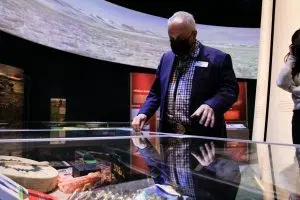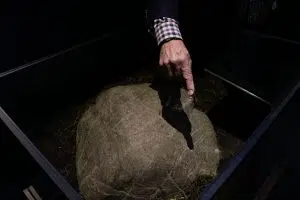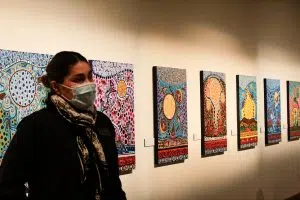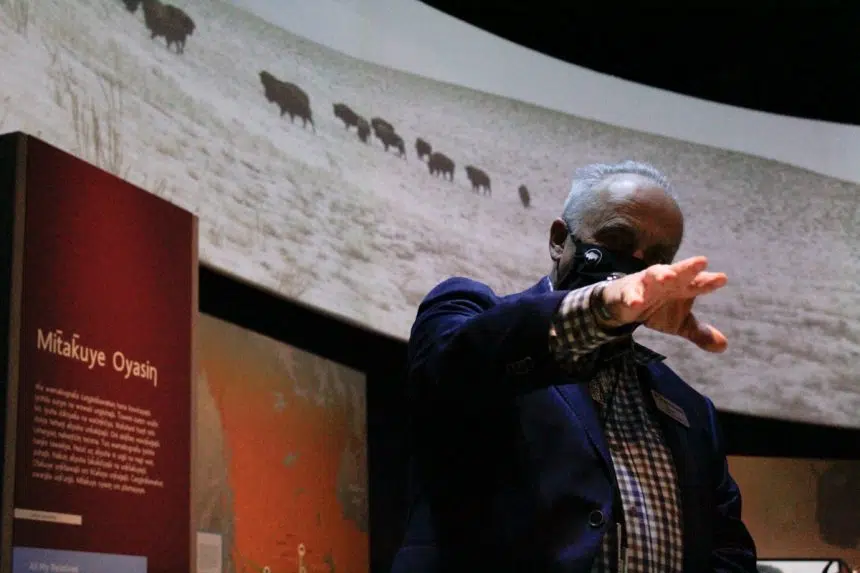A heritage park just outside of Saskatoon is hoping a recent discovery will solidify its bid to receive UNESCO world heritage site designation.
Dr. Ernie Walker, the lead archaeologist at Wanuskewin Heritage Park located just north of Saskatoon, is optimistic the discovery of four petroglyphs — rocks with images carved into them — will strengthen the park’s application to become a UNESCO world heritage site.
Wanuskewin Heritage Park features several bison-related sculptures created by Saskatchewan sculptor Lloyd Pinay. They were added to the park during its most recent renewal project.
Pinay’s first sculpture is located near Queen’s Rock. It’s a live piece of limestone carved as a rib stone, a large stone carved in the shape of an animal’s rib cage. Emerging from the rib stone is a bronze bison.
“It’s the origin story of where the bison came from,” Walker explained.
Closer to the building, a sculpture shows three bison — a bull, a cow and a small calf — running. Upon closer look, viewers can see a female figure waving her arms high to stampede the bison. A man in a bison cape and horns is maneuvering the animals until they reach an alabaster bronze shaman, who spiritually calls the animals to the bison jump on the other side of the Wanuskewin building.

Archaeologist Dr. Ernie Walker explains a showcase display at Wanuskewin on Dec. 6, 2021. (Libby Giesbrecht/650 CKOM)
“We’re mimicking, with sculptural elements, a ritual bison drive. How do you maneuver a herd of animals to go over a precipice is the basic idea,” said Walker.
The archaeologist had no idea how symbolic those sculptures would be in the face of the park’s most recent discovery.
“Things have happened here all through the years that some might say are just little miracles,” Walker said.
The petroglyphs were uncovered in the most natural way possible: By the bison that roam about 850 metres west of Wanuskewin’s main building.
“You couldn’t be on the planet in Saskatoon and not know this,” Walker said, recalling the discovery.
He said he was alongside Wanuskewin bison manager Craig Thoms in the bison paddock feeding the animals at the time.
“We’re prone to visit a lot so we stand off to the side and visit and I look down at my feet and there’s just about this much of this boulder,” Walker said, indicating with his hands a small portion of what would turn out to be a sizable rock.
Walker said he saw grooves on the rock and thought at first it might be damage of some kind until they fully uncovered it. Then he began to see all the irregular grooves and picked out images of a vertebrae, a small triangular head, two little horns, an oblong body and a tail that disappears into a crack on the stone.
“It’s like a little spirit figure,” Walker said.
The boulder is something Walker called a rib stone, much like Piney’s sculpted rib stone that is featured in front of Wanuskewin’s plaza. Walker didn’t have an explanation for that coincidence.
Rib stones, he explained, are about femaleness — the essence of being a female — as well as renewal, revitalization and bison.
“This is why they’re sometimes connected to bison drops,” Walker added. “Females in plains societies have special relationships with bison and this is how they portrayed (a bison drive). (It’s) absolutely magnificent that we came across these.”
Their next discovery came when a smaller stone piece was found about 10 centimetres below the south side of the rock.
“I recognized, clearly, it’s a biface, it’s a stone knife … and the width of it is the same width as the grooves,” Walker said.
“Fourteen hundred years ago, somebody did their thing and dropped the tool and walked away. That never happens, never, ever, ever. It’s one of those things,” he continued.

Archaeologist Dr. Ernie Walker points to grooves on a recently-discovered stone. (Libby Giesbrecht/650 CKOM)
That boulder was one of four rib stones that have now been found at Wanuskewin — three larger stones and a smaller handheld rock. The stones were found laying along what would have been the path bison would have been herded to be stampeded over a nearby cliff by Indigenous people during a bison drive.
Wanuskewin has two bison jumps on its land. The smaller of the two, which was found in 1982, was named the Cree word for “four stones.”
The discovery of the four petroglyphs, 40 years after that jump was found, gives new meaning to the name.
“What it means is this ancient bison drive is intact. The remnants of it are still there,” Walker said. “And this becomes part of this larger story.”
Walker said the find is crucial to Saskatoon’s connection to the bison jump and the city’s history as “bison central.”
UNESCO world heritage site bid
In 1992, Wanuskewin opened to great fanfare, as Walker described, as a site celebrating First Nations heritage in Saskatchewan.
The early years came with some difficulty, largely because there was debate about what the park should be — a museum, an educational facility, or a cultural centre, for instance — until it was realized the park would be all of these things.
An expansion to the site was made in 2007-08 to try and overcome some deficiencies, but Walker said it didn’t do enough for the park. By 2013, a further refresh was needed, and Wanuskewin began planning for a bigger revitalization.
When looking for financial backing, a potential sponsor promised funds to Wanuskewin to do its expansion if park officials could tell the sponsor how the site would be magnificent and unique, going further than just refreshing a few exhibits.
Walker said there was only one answer to that: Turning the site into a UNESCO world heritage site, the gold standard.
“Easier said than done,” he said wryly.

Wanuskewin CEO Darlene Brander in one of the park’s gallerys on Dec. 6, 2021. (Libby Giesbrecht/650 CKOM)
The process is one he said is highly political and expensive, and Wanuskewin’s new building was part of that.
Walker estimated the recently unearthed petroglyphs to be around 1,475 years old.
“This will play a huge role in our submission and we didn’t know they were there,” he said. “We will get it.”
It will take some time, though, for that submission to be fully realized. Walker said the hope was for Wanuskewin to have a submission ready in the near future, with a decision ultimately made in June of 2025 in Paris.
In the meantime, Walker said the discovery has piqued interest in the local community since word of the petroglyphs has spread, seemingly turning everyone’s backyard into a dig site.
“It seems like the entire world has petroglyphs all over their yards (and) all over their pastures. Everybody’s finding bison skulls (and) arrowheads. It’s like daily. I can’t keep up with it,” he laughed.
Walker said the find is going to benefit Wanuskewin, but like all archaeological discoveries, it means more than just an object.
“It’s not about artifacts, it’s not about the things you can see … It’s the story the artifact tells you,” Walker said.
“There are people in Saskatchewan who think, ‘There’s nothing in Saskatchewan to see. It’s flat and boring.’ What are these people talking about?”











